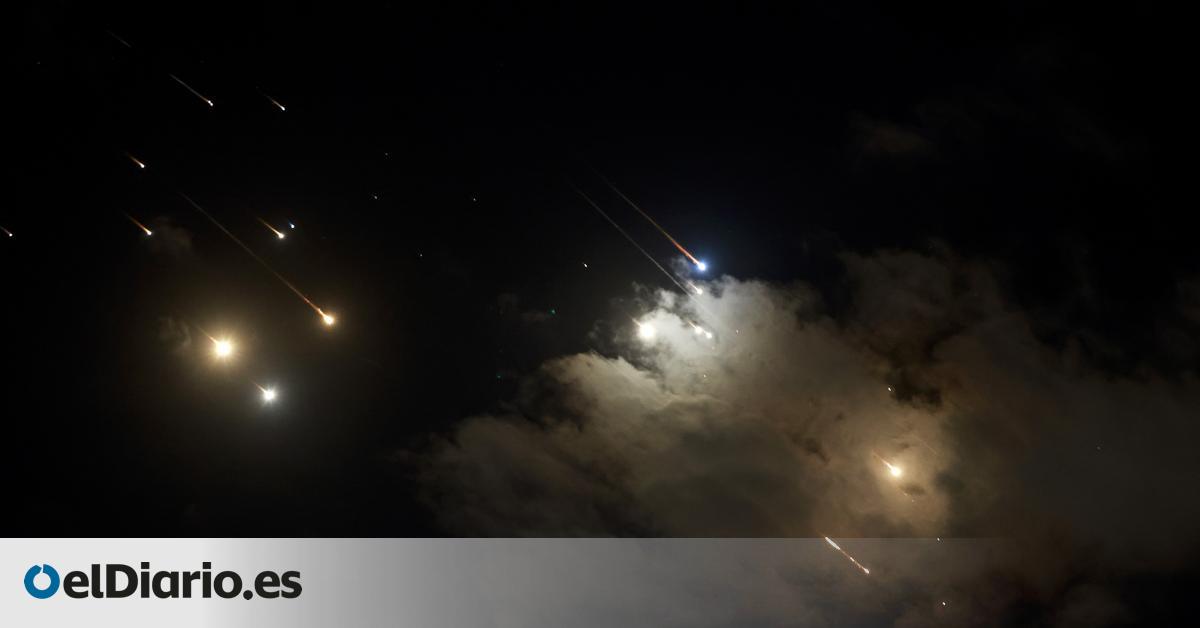
Iran launched a barrage of ballistic missiles at Israel on Tuesday, many of which have been intercepted by the country’s defenses with the help of the United States. Benjamin Netanyahu’s Army announced the start of the attack after 7:30 p.m. local time, giving instructions to citizens to take shelter in safe places, before ending it approximately an hour later.
The attack follows massive Israeli bombings against Tehran-backed Hezbollah in Lebanon in recent days, followed by Tuesday’s ground invasion, the extent of which is still unclear.
The Iranian Revolutionary Guard has confirmed the launch of missiles in response to the assassinations of Hamas leader Ismail Haniyeh, Hezbollah chief Hassan Nasrallah and an Iranian general. “With the firing of dozens of ballistic missiles, targets have been hit in the heart of the occupied territories,” the elite military body has indicated. “If the Zionist regime responds to the Iranian operation, it will face harsh attacks,” he said, according to the IRNA agency. For its part, the Iranian mission to the UN has defended the attack, claiming that it is a “legal, rational and legitimate response to terrorist acts” by Israel, while Hamas has also praised the Iranian action.
Israel has said the attack “will have consequences.” “We will choose when to take the price,” said Israeli Army Chief of Staff Herzi Halevi. “We have plans and we will act at the time and place we choose,” said Daniel Hagari, spokesman for the Israel Defense Forces, moments before, who was in charge of reporting that the attack had ended, ensuring that there were no more. threats” coming from Iran towards Israel, while citizens were notified that they could leave the bomb shelters.
The Israeli spokesperson also added that, at the moment, the authorities do not know if there are any victims. Earlier, emergency services had reported that two people had been slightly injured in Tel Aviv as a result of the attack. Haaretz cites a defense source as saying that a Gazan has died in the city of Jericho, in the occupied West Bank.

Hagari has reported that “quite a few” missiles have been intercepted and that there are some hits “in the center and in southern areas of the country.” According to various media reports, Israeli forces have identified approximately 180 ballistic missiles. At press time, it was unclear how many had hit any targets and impact damage was being assessed, but most of the projectiles have been shot down. Throughout the launch, witnesses spoke and shared images mainly of missiles flying over the area.
During the attack, sirens have sounded throughout Israel, disrupting its airspace, and explosions have been heard in Tel Aviv and Jerusalem. According to the Israeli Army, the explosions corresponded to “interceptions or fallen projectiles.”
Iran’s state news agency IRNA has published images of the projectiles flying through the country’s skies. The missiles from Iran have been sighted in the skies over Jordan, which during the attack last April intercepted the projectiles in its airspace, preventing them from reaching Israel. They also appear to have flown over southern Syria.
The United States has stated that it has mobilized Navy destroyers to defend Israel and has assured that it will consult with its ally on the response against Iran. White House National Security Advisor Jake Sullivan has spoken of “significant escalation” by Iran, while calling the attack “ineffective.” “Based on what we know so far, this attack appears to have been defeated,” Sullivan said.
Previously, the White House had reported that Joe Biden has ordered the US military “to help defend Israel against Iranian attacks and shoot down missiles targeting Israel.”
The US warned a few hours before the attack
The US was precisely the one who raised the alarm about the attack a few hours before it began, informing the press through a senior official that Iran was preparing the “imminent” launch of ballistic missiles against Israel and also warned of “serious consequences.” ” in case it occurred.
“The United States is actively supporting defense preparations to defend Israel against this attack,” the same source indicated.
The Pentagon has stated that, in its assessment, the missile barrage had approximately “twice the range” of last spring’s Iranian attack.
Last April, Iran launched its first direct attack against Israel, with more than 300 missiles and drones that were mostly intercepted before reaching Israeli airspace or before impacting the country. This was made possible by the intervention of US forces and other Western and Arab allies of Israel, which supported Israeli air defenses against the hail of projectiles.
Israeli Prime Minister Benjamin Netanyahu issued a warning this Monday to Iran, which supports Hezbollah in Lebanon and Hamas in Gaza. “There is nowhere in the Middle East that Israel cannot reach,” Netanyahu declared, just days after an airstrike south of Beirut kill the leader of the Lebanese groupHassan Nasrala.
Hezbollah’s acting leader, Naim Kassem, vowed that the group would continue fighting after the death of its leader. Israel has also killed several of the group’s top commanders in recent days. Kassem stated that the group’s fighters are prepared and that the slain commanders have already been replaced.
Moments before Iran launched its missiles, A shooting has left at least six dead and several injured in the Yafa neighborhood, near the tram station south of Tel Aviv.
Source: www.eldiario.es

